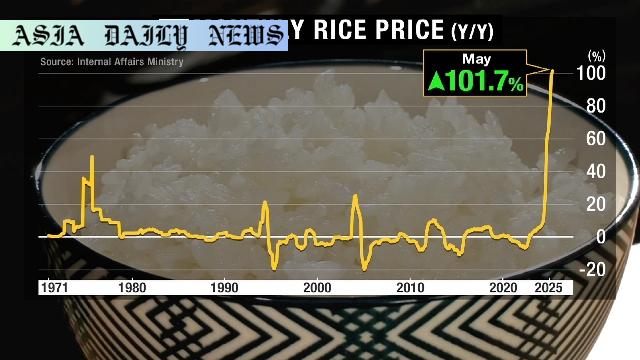Inflation continues to rise as rice prices in Japan soar to a record-high 101.7%, the largest increase since 1971.
- High rice prices are driving up consumer inflation in Japan, reaching a record 101.7% increase in May.
- This is the highest rice price increase since records began in 1971.
- The Consumer Price Index (CPI), excluding fresh food, rose by 3.7% year-on-year in May.
- Popular rice-based dishes such as onigiri balls and sushi have also seen significant price hikes.

Record-Breaking Rice Prices in Japan
In May, Japan experienced an unprecedented surge in rice prices, which doubled compared to the previous year, marking a 101.7% increase. This significant jump represents the highest rise since the government began recording comparable data in 1971. Staple foods in Japanese households, such as rice, are a critical component of daily meals, and this historic increase has had widespread implications.
The rise in rice prices has not only affected consumer households but also the restaurant industry. Popular dishes like onigiri (rice balls) and sushi have experienced price hikes of over 19% and 6%, respectively. With rice being a central element of Japanese culture, these changes are impacting food affordability and choices across the nation. The surge in prices reflects broader inflationary pressures, compounded by changes in production costs, climate impacts on agriculture, and supply chain disruptions.
Broader Inflationary Trends
The rise in rice prices is part of a larger trend of increasing consumer inflation in Japan. In May, the Consumer Price Index (CPI), which excludes fresh food prices, rose by 3.7% compared to the previous year. This figure is up 0.2 percentage points from April, marking the sixth consecutive month that CPI readings have remained above 3%—a stark signal of inflationary persistence in the economy.
Experts attribute these inflationary pressures to a variety of factors, including rising global commodity prices, depreciation of the Japanese yen, and supply chain difficulties that have lingered following the pandemic. Farmers also face hurdles such as higher fertilizer costs, water shortages, and fluctuating temperatures, further elevating the cost of producing staple crops like rice. These upstream challenges are inevitably passed down to the consumer, intensifying their financial burden.
The Pressure on Consumption
The economic impact of inflation in Japan is being felt directly at the consumer level. As rice prices rise, expenditures on food continue to grow for households. This reduces disposable incomes for other goods and services, potentially slowing overall economic growth. Furthermore, with a reliance on rice as an essential food source, there is little flexibility for many families to substitute with other, cheaper alternatives.
The restaurant industry has also struggled under these conditions. Japanese cuisine heavily integrates rice into its offerings, leaving little room for menu adjustments without affecting the core essence of traditional dishes. The increase in prices may also discourage consumers from dining out, affecting economic activity in the hospitality sector.
Future Outlook
Moving forward, the Japanese government faces the tenuous challenge of managing inflation pressures while ensuring food security for its population. Mitigation strategies, such as increased subsidies for domestic farmers and policies to stabilize commodity imports, are critical. Additionally, promoting innovation in agricultural practices to increase yields and adapt to climate challenges will be essential.
The importance of rice in Japanese culture further elevates the urgency of addressing these rising prices. With inflation reaching the highest levels in decades, the government, businesses, and consumers must work together to navigate the challenges ahead. Balancing economic growth with affordability and sustainability will remain a complex yet crucial goal in the coming months.



Commentary
The Cultural and Economic Significance of Rice in Japan
The soaring rise in rice prices in Japan is more than just an economic issue; it is cultural in nature. Rice has been a cornerstone of Japanese cuisine and tradition for centuries, symbolizing nourishment, prosperity, and community. However, as prices skyrocket, this emblem of cultural pride has become a source of financial strain for countless households.
The sharp jump of 101.7% in rice prices is unprecedented, but it’s crucial to assess why this is happening. From a global perspective, supply chain complications, rising costs of production, and climate change have compounded to create an unstable agricultural landscape. Japan, despite its advancements, is not immune to these global shifts. Farmers face increasingly volatile conditions, while the cost of importing commodities remains high due to a weak yen. This domino effect trickles down to the average consumer, forcing them to make difficult choices when purchasing groceries or dining out.
Impact on Consumer Behavior and Businesses
Beyond the immediate economic implications, these rising costs are also altering consumer behavior. Consumers are likely to reevaluate their spending habits, cutting back on dining out or opting for cheaper alternatives—a trend that directly impacts businesses in the hospitality sector. Traditional sushi restaurants or convenience stores that rely on affordable onigiri sales may find it challenging to maintain profitability amidst fluctuating prices.
However, this period of financial difficulty can also spark innovation. The government might promote new policies for agricultural sustainability, such as introducing heat-resistant rice strains or utilizing advanced irrigation technologies to combat climate-induced challenges. Businesses, too, may innovate by diversifying their menus to reduce reliance on high-cost ingredients like rice, ensuring competitiveness even amidst high inflation periods.
The Broader Lesson for a Global Economy
Japan’s current inflationary challenges serve as a microcosm of a global issue. Countries across the world are facing similar challenges—ranging from supply chain disruptions to increased food costs. Japan’s case highlights the balance governments must strike between inflation control and economic growth. Measures that both protect consumers and provide stability for producers will be critical in alleviating the strain.
Ultimately, the soaring price of rice is not just a financial challenge but a reflection of the interconnectedness of cultural staples, global economic shifts, and environmental challenges. The manner in which Japan navigates this issue will likely serve as an example for other nations facing similar pressures, demonstrating how to preserve the core of cultural identity while addressing economic realities.